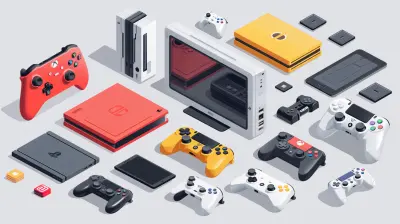The Influence of Japanese Gaming Culture on Modern Consoles
25 November 2025
Video games have come a long, long way—from pixelated characters hopping across screens to immersive open worlds that can steal hours from your day. But let’s rewind the tape a bit. Have you ever wondered why modern consoles like the PlayStation, Switch, and Xbox look and feel the way they do? A huge chunk of that answer lies across the Pacific, in the unique and wildly imaginative world of Japanese gaming culture.
In this article, we’ll dive deep into how Japan’s gaming heritage—shaped by quirky innovation, dedicated fandoms, and a distinctive approach to game design—has carved a lasting legacy in the hardware and user experience of modern consoles. Buckle up because this is going to be a nerdy, nostalgic, and eye-opening ride.
The Birthplace of Console Gaming
Before we zoom into the influence, we’ve got to set the scene.Japan isn't just a player in the console world—it practically invented the game. In the early ’80s, while Western companies were fumbling with clunky arcade ports and home computers, Japanese companies were cooking up something revolutionary: dedicated home gaming systems.
Remember the NES (Nintendo Entertainment System)? Launched in Japan in 1983 as the Famicom, it became a global phenomenon that pulled the gaming industry out of its infamous ‘video game crash’. That’s right—the world owes a big “arigatou” to Nintendo for putting games on the map again.
So why was Japan such a hotbed for this innovation? It boils down to three key ingredients:
1. A Culture of Miniaturization – Japan loves compact, efficient design (just look at Tokyo apartments or bento boxes).
2. An Obsession with Quality – Japanese creators approach game-making like an art form.
3. A Unique Perspective on Fun – Games weren’t just about winning; they were about charm, creativity, and emotional stories.
These ingredients didn’t just change how games were made; they changed what gamers expected from a console.
Hardware Innovations: Small But Mighty
Let’s talk gear. One of the biggest ways Japanese culture has influenced modern consoles is through the hardware itself. Japanese tech companies—Sony and Nintendo leading the charge—have always emphasized sleek, compact, and user-friendly designs.The Nintendo Touch
Nintendo has always marched to the beat of its own drum.- Game Boy (1989): Portable gaming wasn’t new, but Nintendo made it mainstream. It wasn’t flashy, but it was reliable—and fun.
- Nintendo DS & 3DS: Touch screens, dual displays, and eventually, 3D visuals. These weren’t aimed at tech enthusiasts—they were made for everyone from your grandma to your 7-year-old niece.
- Nintendo Switch: Hybrid console gaming? Genius. You can play on your TV, in bed, on a plane, or even in the bathroom (don’t judge).
What do all these have in common? A philosophy that values accessibility, portability, and social interaction, which are deeply rooted in Japanese lifestyle and gaming habits.
Sony: Power Meets Style
Sony, on the other hand, took a different path. While Nintendo leaned into family-friendly innovation, Sony chased cinematic experience and raw horsepower.- PlayStation One to Five: Sony’s consoles have consistently pushed graphical capabilities and immersive gameplay. But even here, the Japanese influence is clear—sleek design, deep attention to UI, and a focus on storytelling and characters.
Even today, the PS5’s futuristic design screams precision and elegance. It's like the tech version of a katana—sharp, sleek, and deadly efficient.
Storytelling and Character-Driven Design
You know those games that stick with you long after you’ve finished them? Odds are, they're Japanese in origin.Japanese developers have a knack for storytelling. Whether it’s existential crises in Final Fantasy, emotional journeys in The Legend of Zelda, or psychological horror in Silent Hill, these narratives dig deep. And it isn’t just about big plots—it’s the characters. From Mario to Cloud Strife, these icons are globally recognized, and that’s no accident.
Modern consoles have evolved to support these types of games. Higher GPU power, larger storage, cloud saving—these all cater to massive games with rich narratives and character development. And guess where the push for those types of experiences originally came from? You guessed it—Japan.
The Role of Arcade Culture
Now, let’s swing the camera to arcades. In Japan, arcades weren’t just a phase—they were (and in some places, still are) a way of life. Entire buildings in Akihabara are dedicated to claw machines, rhythm games, and fighting game battles that resemble underground boxing matches.This arcade culture did more than entertain—it shaped how games were designed.
- Fast, responsive controls
- Replayability
- Competitive elements like leaderboards and PVP modes
These foundational elements transitioned into consoles, especially through series like Street Fighter, Tekken, and Dance Dance Revolution. Even modern esports owes a salute to Japanese arcades for laying the groundwork.
Quirks and Charms: Only in Japan
Japanese games and consoles aren't afraid to be weird. And we love them for it.Whether it’s a game about dating birds (Hatoful Boyfriend), a fridge-shaped console add-on (hello, PS2’s weird accessories), or bizarre RPG plotlines, Japan thrives in embracing the strange and quirky. This willingness to deviate from the norm has injected creativity and surprise into modern gaming.
Western developers and console makers picked up on that vibe. Today, you’ll find more offbeat, indie-style games even on AAA platforms. And hybrid games that blend genres? Yup, that’s very much a Japanese hallmark.
The Social Side of Gaming
Multiplayer gaming isn’t just about competition—at least not in Japan.Japanese gaming culture leans into cooperative experiences. Think Monster Hunter, where you team up to take down massive beasts instead of just sniping strangers on the internet. Or Animal Crossing, where the most violent thing you can do is shake someone’s tree.
This philosophy has influenced social features in modern consoles:
- Party chat systems
- Easy friend invites
- Co-op game modes that prioritize fun over K/D ratios
Sony and Nintendo both lean hard into these aspects. Even Microsoft has tried to emulate this with features like Xbox Live’s party system and Game Pass multiplayer incentives.
Collectibles, Customization, and Community
Another point of influence? The collector’s mindset.In Japan, gaming culture often overlaps with otaku (fandom) culture. People don’t just play games—they live them. Limited edition consoles, special character skins, in-game badges, and more feed this love for collecting and customizing.
Modern consoles have baked this into their ecosystems:
- In-game items you can buy, trade, or show off
- Virtual avatars and environments
- Limited-edition hardware with character themes
It’s not just about playing anymore—it’s about curating your gaming identity. That idea started in Japan, and now it’s mainstream.
Cross-Cultural Fusion: Japan Meets the World
Of course, we can’t ignore that influence flows both ways. While Japanese gaming culture has deeply shaped modern consoles, Western innovation and audience preferences have also played a role.However, the brilliance lies in balance. Japanese console makers, especially Sony and Nintendo, have figured out how to maintain their unique identity while designing systems that cater to global markets.
👉 Take the PS4 and PS5—they have Western-appeal games like Call of Duty, but sit right next to niche titles like Persona 5.
👉 Or the Switch, which featured indie darlings and retro remasters alongside Zelda and Mario.
This fusion style—rooted in Japanese culture but with a global lens—is what makes modern consoles so versatile and universally loved.
Looking Ahead: The Future of Japanese Influence
So what's next?Japan’s gaming culture is far from done shaping the industry. As the world moves toward cloud gaming, VR, and AI-driven experiences, Japanese developers are already one step ahead, experimenting with:
- Emotion-driven AI companions (think Tamagotchi on steroids)
- Story-rich VR experiences
- Augmented reality games like Pokémon Go 2.0
Even the concept of gaming as part of daily life—a lifestyle, not a hobby—has its roots in Japan. Think fitness games, brain trainers, and mobile-console hybrids. This idea is only going to grow.
Final Thoughts
It’s impossible to separate the DNA of modern consoles from the rich, vibrant, and sometimes downright wacky influence of Japanese gaming culture. From the way controllers fit in your hand, to the stories that make you cry, to the quirky games you didn’t know you needed until you played them—Japan’s impact is everywhere.So next time you boot up your console, maybe give a little bow of thanks to the brilliant minds in Kyoto and Tokyo who made it all possible.
Game on.
all images in this post were generated using AI tools
Category:
Gaming ConsolesAuthor:

Pierre McCord
Discussion
rate this article
1 comments
Atlas Mathews
Japanese gaming culture redefined consoles—innovation meets tradition in every pixel and button.
November 26, 2025 at 4:49 AM


